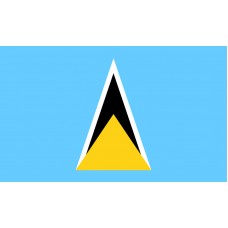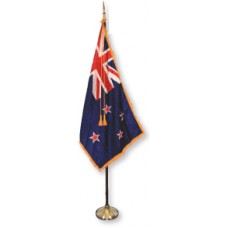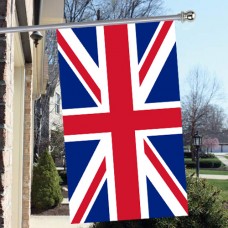St. Lucia Flag
We carry authentic St. Lucia Flags in both indoor and outdoor varieties. Our flags are proudly made in the United States from durable nylon and are printed with vibrant long-lasting inks. The St. Lucia national flag is often displayed at embassies, outside of businesses associated with St. Lucia, and at the homes of people who take great pride in their St. Lucian heritage.
Our indoor flags are finished with a pole hem and your choice of with or without golden fringe. Gold fringe is the traditional way to display an indoor flag, however, some people choose without fringe for a simple and clean look that is also less expensive. If you are looking for a complete indoor presentation set, our Build Your Own Indoor International Flag Set program allows you to select a durable nylon indoor St. Lucia Flag and choose between premium quality poles, bases, and ornaments, and tassel. For indoor applications, most buyers choose a 3ft. x 5ft. flag with an 8ft. pole, however, if you have a low ceiling, you may opt for a 7ft. pole, which is designed to work with drop ceilings. If you are looking for a very substantial international flag display, our 4ft. x 6ft. indoor flags can be paired with a 9ft. pole for our largest indoor display option.
Our outdoor international flags are finished with a canvas header and brass grommets and are offered in four sizes: 2ft. x 3ft., 3ft. x 5ft., 4ft. x 6ft., and 5ft. x 8ft., to fit any sized flagpole. Typically, outdoor flags are flown outside of government organizations, businesses, and institutions on in-ground and wall-mount flagpoles, however, some people also buy these flags to display their international pride at home. If you are looking for a wall-mount St. Lucia flag set to display outside of your home, our Build Your Own Outdoor International Flag Set program will allow you to choose between premium quality 6ft. poles and brackets to display the St. Lucia Flag on your front porch. Outdoor flags can also be displayed indoors on interior walls of your home with screws anchored in the wall to attach to the grommets.
In addition to the flags we offer for purchase, we maintain an archive of historical information about the St. Lucia flag, demographic data about St. Lucia, and free high resolution images of the St. Lucia flag for use in projects and on websites.
Regardless of your application, we are looking forward to working with you to provide the required flags, flagpoles, and hardware for your application. If you need assistance, please reach out to us by phone, email, or chat, and we will be happy to help.
History of the Saint Lucia Flag
The Saint Lucia Flag features a light blue field with a yellow triangle in front of a black triangle with a white border in the middle. The blue color represents the sky and the sea, particularly the Atlantic Ocean and the Caribbean Sea, the black and white colors represent the harmonious and calm relationship between the black and the white races, and the yellow color represents the sunshine and hope and prosperity. The triangles represent the Pitons which are the twin volcanic peaks, known as Gros Piton and Petit Piton. The Saint Lucia flag was adopted on March 1st, 1967, twelve years before it became an independent country and was designed by Dunstans Omer, who was an artist from St. Lucia.
Saint Lucia is an island country that is located in the Caribbean Sea. It is one of the Windward Islands (the second largest) and it is part of the Lesser Antilles islands. The capital and largest city is called Castries. The island of St. Lucia was named after Saint Lucy of Syracuse, and is the first country in the world to be named after a woman. It is thought that French shipwrecked sailors named the island after being shipwrecked on December 13th, the Saint's Feast days and it was the French that were the first Europeans to ever colonize the island.
In 1660, the French took control of the country following a treaty that was signed with the Carib Indians. In 1664, Thomas Warner claimed St. Lucia for England and he brought one thousand men with him to try and protect it from the French. In 1666, The French West India Company gained control and by 1667, it was made an official French colony. In 1814, the British took control after the French surrendered. From 1660 until the British took complete control in 1814, control of the country kept switching between the British and the French. Control of St. Lucia changed 14 times (each country gained control 7 times) and the country became known as "Helen of the West Indies." St. Lucia was under the control of the British until February 22nd, 1979, when it gained full independence.
St. Lucia's economy is heavily reliant on its exports and tourism. The main exports of St. Lucia are bananas, coconuts, and cacao as well as oil, gas, and petrol. Tourism is also another major contributor as it is a very popular country to visit with many beautiful and scenic sights to see, such as the Sulphur Springs, also known as the "world's only drive-in volcano" as people can drive to the edge of the springs. Another popular attractions is "Diamond Falls" which is considered to be a St.Lucia "Wonder" and is hone to the best kept and well-conceived gardens, a waterfall whose mineral deposits make the water colored and for its healing hot spring baths. The majority of tourists that do visit St.Lucia are normally cruise-ship passengers.
Geographic Coordinates
Area
Population
Life Expectancy
Government Type
Capital
GDP
Unemployment
Currency
Calling Code
Internet TLD
Download St. Lucia Flag Images
We offer free images of the St. Lucia Flag in four sizes (small, medium, large, and high resolution). These images are distributed royalty free for both personal and educational use and are ideal for use in projects and on websites. If you choose to use one of our images, attribution is appreciated, but not required.
- Small Icon (PNG, 30x15px)
- Medium Image (PNG, 125x63px)
- Large Image (PNG, 525x263px)
- High Resolution Image (PNG, 3000x1500px)
Add the St. Lucia Flag to your Website:
The following html code snippets can be copied and pasted to add an image of the St. Lucia Flag to your website:
Small Flag Icon






